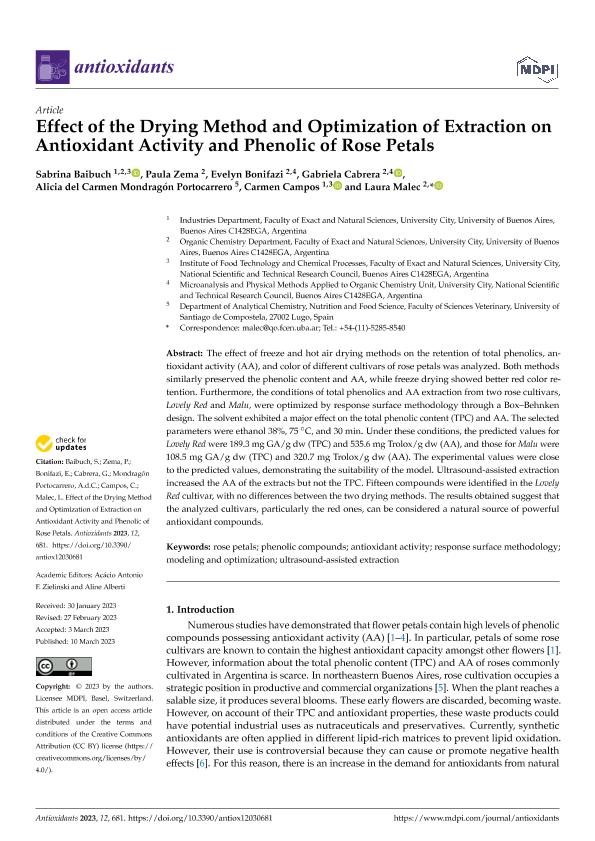Artículo
Effect of the Drying Method and Optimization of Extraction on Antioxidant Activity and Phenolic of Rose Petals
Baibuch, Sabrina Yael; Zema, Paula Daniela ; Bonifazi, Evelyn Lucia
; Bonifazi, Evelyn Lucia ; Cabrera, Gabriela Myriam
; Cabrera, Gabriela Myriam ; Mondragón Portocarrero, Alicia del Carmen; Campos, Carmen Adriana
; Mondragón Portocarrero, Alicia del Carmen; Campos, Carmen Adriana ; Malec, Laura Sara
; Malec, Laura Sara
 ; Bonifazi, Evelyn Lucia
; Bonifazi, Evelyn Lucia ; Cabrera, Gabriela Myriam
; Cabrera, Gabriela Myriam ; Mondragón Portocarrero, Alicia del Carmen; Campos, Carmen Adriana
; Mondragón Portocarrero, Alicia del Carmen; Campos, Carmen Adriana ; Malec, Laura Sara
; Malec, Laura Sara
Fecha de publicación:
03/2023
Editorial:
Multidisciplinary Digital Publishing Institute
Revista:
Antioxidants
ISSN:
2076-3921
Idioma:
Inglés
Tipo de recurso:
Artículo publicado
Clasificación temática:
Resumen
The effect of freeze and hot air drying methods on the retention of total phenolics, antioxidant activity (AA), and color of different cultivars of rose petals was analyzed. Both methods similarly preserved the phenolic content and AA, while freeze drying showed better red color retention. Furthermore, the conditions of total phenolics and AA extraction from two rose cultivars, Lovely Red and Malu, were optimized by response surface methodology through a Box–Behnken design. The solvent exhibited a major effect on the total phenolic content (TPC) and AA. The selected parameters were ethanol 38%, 75 °C, and 30 min. Under these conditions, the predicted values for Lovely Red were 189.3 mg GA/g dw (TPC) and 535.6 mg Trolox/g dw (AA), and those for Malu were 108.5 mg GA/g dw (TPC) and 320.7 mg Trolox/g dw (AA). The experimental values were close to the predicted values, demonstrating the suitability of the model. Ultrasound-assisted extraction increased the AA of the extracts but not the TPC. Fifteen compounds were identified in the Lovely Red cultivar, with no differences between the two drying methods. The results obtained suggest that the analyzed cultivars, particularly the red ones, can be considered a natural source of powerful antioxidant compounds.
Archivos asociados
Licencia
Identificadores
Colecciones
Articulos(UMYMFOR)
Articulos de UNID.MICROANAL.Y MET.FISICOS EN QUIM.ORG.(I)
Articulos de UNID.MICROANAL.Y MET.FISICOS EN QUIM.ORG.(I)
Citación
Baibuch, Sabrina Yael; Zema, Paula Daniela; Bonifazi, Evelyn Lucia; Cabrera, Gabriela Myriam; Mondragón Portocarrero, Alicia del Carmen; et al.; Effect of the Drying Method and Optimization of Extraction on Antioxidant Activity and Phenolic of Rose Petals; Multidisciplinary Digital Publishing Institute; Antioxidants; 12; 3; 3-2023; 1-15
Compartir
Altmétricas



